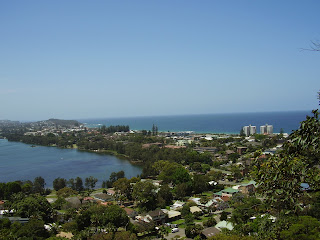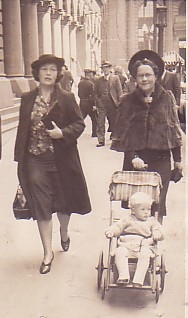There’s been much mention here of Narrabeen, the seaside suburb on Sydney’s Northern Beaches, where I was raised. I recently had an opportunity to, quite literally, take a nostalgic walk down Memory Lane and, as a consequence, compiled this photo essay. Come join me on my walk, won’t you? You are very welcome to come along.
^ My friend, George, asked me to take care of his treasured rose garden while he’s on vacation in Queensland. It’ll only be for a week. Just watering and light maintenance. George lives at Narrabeen on Sydney’s Northern Beaches, not far from where I grew-up. One morning, after watering George’s beautiful roses, I decide to set-off on a walk back in time, through my childhood. To get us in the mood, here’s an image of sunrise over the Pacific Ocean, as seen from the cliffs above Narrabeen beach, close to where George lives. (Click on the images to enlarge them)

^ I take the short walk from George’s house, along the lakeside, estuary path that leads to Narrabeen beach, where the lake empties into the Pacific Ocean. It’s a beautiful, bright, clear, summer morning. The air is invigoratingly laced with the brisk, sharp saltiness of sea spray blowing off the ocean. The constant, rumbling ebb and flow of the breakers on the nearby beach accompanies me as I walk on. There aren’t many people out at this early hour.

^ I continue along the path leading to the rocky platform of the reef, below Narrabeen cliffs. There’s a steep, precipitous cliff to my immediate left, a bright yellow and black sign warning, “Beware falling rocks.” To my right is the dazzling, golden sweep of Narrabeen beach as it stretches southward towards Collaroy and Long Reef. Just as I take this snap, an elderly lady tiptoes into frame, tentatively taking a morning paddle. The large building on the beach, to the right of the picture is North Narrabeen Surf Life Saving Club, where sun-bronzed Aussie lifesavers hang-out in their little red speedos. Their "kiss of life" gives them power over life and death.
^ The waves are breaking over the reef as the surf swells, so I decide against progressing further. Instead, I walk along the ocean wall enclosing the rock swimming pool. I have to jump to avoid the waves rolling in, as they crash over the wall. There are a few board riders bobbing on the waves in the distance.
^ I return along the path from whence I came. This is where the waters of the lake narrow, as they progress along their circuitous route, before emptying into the ocean. It looks peaceful on days such as this, but in storms and when there’s a king tide running, this tranquil waterway turns into a deadly, raging torrent, the sandbar swept away and deposited miles out to sea. A school friend of mine was drowned near here. He was English, aged nine, didn’t know the danger. We all lined the street in school uniform, as his hearse passed by. That’s Ocean Street bridge to the left.
^ I continue walking along the lakeside estuary path, almost to the Ocean Street intersection. Before getting there, I take the wooden, cliff-side stairs to the top of the cliff. The stairs are firmly fixed to the heavily wooded cliff-face, making several twists and turns before reaching the top.
^ At the top of the cliff, I come to an overgrown path, leading through the undergrowth. Though it can’t be seen through the dense foliage, I am aware from the sound of the surf pounding on the reef below, that the sheer drop of the cliff is not far away. It’s peaceful here, protected from the biting sea breeze by the surrounding vegetation, the air warm and heavy with the scent of eucalyptus. The hearty, cliff-top scrub has the characteristic look of all such coastal flora – gnarled, bent, windswept, tough.
^ I come to a grassy clearing and walk towards the cliff-top lookout. I take a seat on the park bench to catch my breath, while I enjoy the beautiful view of the coast below.
^ East: The next four photos, commencing with this one, were all taken from the lookout seen in the previous photo and should be viewed as a complete panoramic sequence looking south and reading left (east) to right (west). This first photo is looking due east, straight out to sea. Far below, the ocean waves break on the reef at the base of the cliff. Over the distant curve of the horizon is New Zealand. Beyond that, Chile.

^ South-East: The estuary, where the lake waters pass over the reef and empty into the ocean. Way off in the distance, across the water, can be seen Long Reef, as it stretches out into the Pacific Ocean. It was in Lancaster Crescent at Long Reef that George and I first met in February 1973, through a mutual friend. Long Reef holds so many wonderfully happy memories for me. On a more somber note, Long Reef is where my ashes will be scattered one day. They are to be cast upon the waters on the night of the full moon, as the moon rises out of the ocean and the tide rushes out to sea. But not yet!

^ South: The beautiful Narrabeen coastline. North Narrabeen in the foreground. South Narrabeen, where I grew-up, in the middle distance. Collaroy in the far distance. Long Reef off camera, to the left. It is said that everyone of a certain age knows exactly what they were doing when they heard of JFKs assassination. I’m no exception. I was on that stretch of golden sand in the immediate foreground when I heard. I was studying for my lifesaving certificate, practicing resuscitating a classmate. A fellow student rushed up to us on the sand, excitedly declaring, “Someone shot the American President”.
^ West: The Narrabeen Lake estuary, with the coastal waters of the lake visible beyond the Ocean Street bridge and causeway. The waters of the lake proper stretch off camera to the west.
^ I take the wooden steps down to the lakeside path, which leads to North Narrabeen beach. From there I walk along the beach to South Narrabeen, where I grew up. This photo shows South Narrabeen beach, looking south towards Collaroy in the middle distance and Long Reef in the far distance, as seen from the end of Mactier Street, the street where my childhood home was located. It’s still early, with few people out and about. The air is warm with a refreshing ocean breeze blowing. It was fun to paddle in the sea, as I walked along the beach. The water was quite cold and made my toes tingle.

^ I sit on the beach at the end of Mactier Street and gaze out to sea. If these sands could speak, oh what a tale they would tell. When one thinks of ghosts, the usual imagery that comes to mind is of haunted houses and graveyards. For me, however, here be ghosts! All of them friendly. This was my playground when I was a child. I spent much of my time here. As I sit here today, my parents and many other loved ones from my childhood are not far away. In fact, this apparently deserted beach is not deserted at all. I am surrounded by loved ones here today.
^ For example, here’s a little chap I know very well. His name is Kerry. He is a sensitive, shy, introspective child, who loves to splash and play in the sea. This photo of me was taken at the same place the previous two above photos were taken, on South Narrabeen beach at the end of Mactier Street.
^ I leave the beach and walk directly inland along Mactier Street, where my childhood home was once located. Our humble little seaside house was demolished long ago, to make way for apartments. I walk over the Mactier Street hill and pass by where my Aunty Glad, Uncle Eric and cousin Dorothy once lived, their house also sadly long since gone. Not far from the sea, I come to Narrabeen Lake. I walk along the lakeside path; the big, old, lichen-covered she-oak trees shading my progress. As a child, they reminded me of the apple-throwing trees from The Wizard of Oz. They still do.
^ I take a seat on a park bench, under the shade of the she-oaks, and gaze out over the tranquil waters of the lake. Ducks paddle close to shore. Memories come flooding back to me. This is only a short walk from my childhood home and I had many happy times playing here.
^ I leave the path and walk down to the lake shore. Ducks outnumber people at this early hour. As they glide past, they quack gently to each other, as if in hushed, conspiratorial conversation. The barely perceptible, gently murmuring ebb and flow of the wavelets lap languorously at the shore. The air is moderately warm, carrying with it the distinctly subtle, fecund scent of lake water, mixed with the ever-present perfume of the eucalyptus trees.
^ As I walk back from the water’s edge, I appear to have attracted a cute, waddlesome entourage. I take a seat on a nearby park bench, open my knapsack, and share a banana sandwich with my new-found, feathered friends.
^ The path leads me closer to the reed-beds at the lake’s edge, where the boughs of the she-oaks hang low. It was near here that an old boatshed once stood. We children would hire canoes and paddle off for a day of high adventure, our parents stressing that we must keep close to the shoreline. My maternal grandparents lived next-door to us. My father and grandfather would sometimes hire a row-boat from the boatshed and enjoy a day of fishing together on the lake.
^ The path leads away from the water’s edge and starts to climb through the dense undergrowth towards Collaroy Plateau. This short-cut to the summit is known only to locals, specifically local children. The increasingly steep, serpentine path meanders through the bush as the warmth of the sun shines down on my back. In time, the path gives way to steep steps, cut into the bedrock of the escarpment.
^ A beautiful vista greets me at the top.
^ Narrabeen coastline, looking north. The headland in the distance is where I started my walk. I walked along the beach to Mactier Street and then walked inland to the lake. In the foreground, to the left of this picture, near the lake’s edge, can be seen a traffic roundabout. That’s Mactier Street, where I was raised. My family lived at the ocean end of the street, to the right, off camera. In 1770, Captain James Cook sailed up the coast here, as he charted the Australian east coast in his ship, His Majesty’s Barque Endeavour. Cook claimed the east coast under instruction from King George III of England on 22 August 1770, naming eastern Australia “New South Wales”.
^ Captain James Cook RN, 1728–1779
^ Long before the arrival of Captain Cook, there lived on the banks of this lake an Aboriginal princess named Narrabeen. In the local Aboriginal dialect, the word Narrabeen means “Swan”. At school, we were taught the legend about the heroic young woman, Narrabeen, who ran to seek help from friendly neighbours, when her people were under attack from a hostile, invading tribe. Narrabeen, the seaside suburb of Sydney, is located approximately 23 km (14 miles) north of the city.
^ And so I walk back to North Narrabeen via Ocean Street and pick a lovely bunch of George's beautiful roses from his garden (He said I could!) before driving home to Sydney's Inner West, where I live. The roses look stunning on my coffee table.


















































